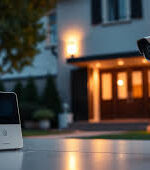
When planning a security system for your home or business, one of the most common questions is: How many security cameras are actually necessary? The right number depends on several factors—including property size, layout, security goals, and the type of cameras being used. While there’s no one-size-fits-all answer, understanding your specific surveillance needs is key to creating an effective security solution.
For a standard home, most setups require 4 to 8 cameras. A typical configuration includes cameras at all major entry points—front door, back door, and side entrances. Additional cameras are often placed to monitor the driveway, garage, backyard, and main living area inside. Homes with larger yards or multiple floors may need more coverage to eliminate blind spots and ensure full perimeter security.
Businesses usually require more extensive coverage, depending on the size of the property and the nature of the operations. A small retail store may only need 6 to 10 cameras to cover entry points, the cash register, aisles, and the storeroom. Meanwhile, a warehouse or office complex may need 12 to 32+ cameras, covering every exterior wall, loading dock, hallway, exit, server room, and communal space.
Outdoor cameras are essential for perimeter monitoring, while indoor cameras are useful for monitoring assets and employee activity. Some advanced systems even include PTZ (pan-tilt-zoom) or AI-powered cameras for dynamic monitoring and facial recognition in high-security areas.
It’s also important to consider the camera’s field of view. Wide-angle lenses can reduce the number of cameras needed by covering larger areas, whereas narrow-angle cameras may require more units for comprehensive coverage.
Another important consideration is system scalability. Starting with the most critical zones and expanding later allows you to grow your system as your needs evolve. At KANCAM, we help clients identify key surveillance zones and build a custom solution using a mix of high-definition, weatherproof, and motion-detecting cameras.
Ultimately, the goal isn’t just to install a large number of cameras, but to ensure strategic placement that delivers complete coverage with minimal redundancy. With expert planning and installation, even a modest number of cameras can provide robust 24/7 security.





